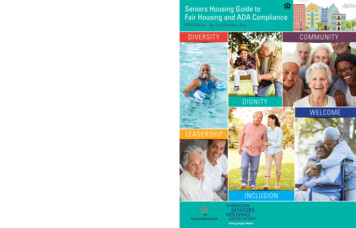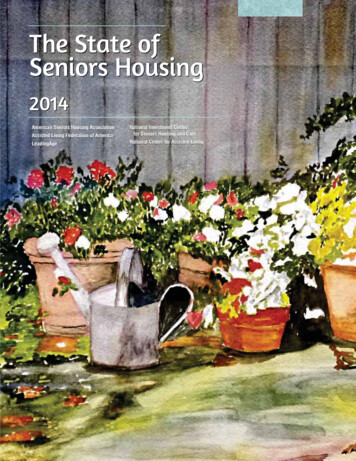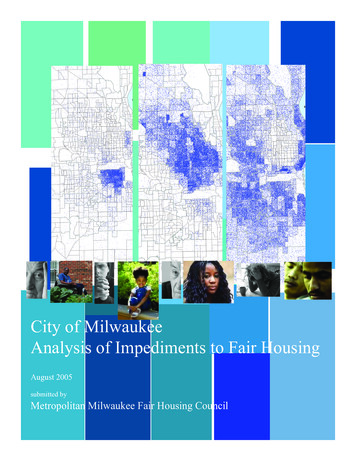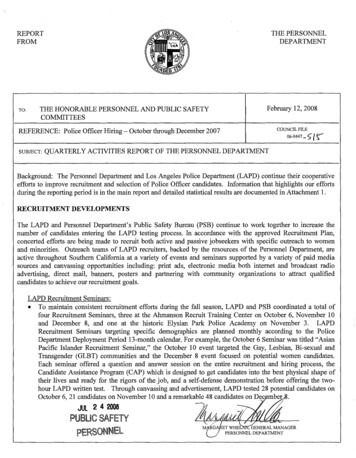
Transcription
Seniors Housing Guide toFair Housing and ADA ComplianceFifth Edition By Paul Gordon, Esq.Seniors Housing Guide to Fair Housing and ADA ComplianceDIVERSITYCOMMUNITYDIGNITYASHA Wishes to Gratefully Acknowledgethe Generous Support of Ventas, Inc. for this PublicationWELCOMEFifth Edition By Paul Gordon, Esq.LEADERSHIPINCLUSIONASHA
2016 by the American Seniors Housing AssociationAll rights reserved. The text portions of this work may not be reproduced or transmittedin any form or by any means, electronic or mechanical, including photocopying,recording, or by information storage and retrieval system without permission in writingfrom the publisher.This publication is designed to provide accurate and authoritative information in regardto the subject matter covered. It is distributed with the understanding that the publisheris not engaged in rendering legal, accounting, or other professional services. If legaladvice or other expert assistance is required, the services of a competent professionalperson should be sought. From a Declaration of Principles jointly adopted by aCommittee of the American Bar Association and a Committee of Publishers.Price: 35.00 (non-members)
Seniors Housing Guide to Fair Housing and ADA Compliance 1Seniors Housing Guide toFair Housing and ADA ComplianceFifth Edition By Paul Gordon, Esq.BALANCING RIGHTS AND RISKS
2 Seniors Housing Guide to Fair Housing and ADA Compliance
Seniors Housing Guide to Fair Housing and ADA Compliance 3TABLE OF CONTENTSIntroduction . . . . . . . . . . . . . . . . . . . . . . . . . . . . . . . . . . . . . . . . . . . . . . . . . 4Executive Summary. . . . . . . . . . . . . . . . . . . . . . . . . . . . . . . . . . . . . . . . . . . 6Use Of This Guide . . . . . . . . . . . . . . . . . . . . . . . . . . . . . . . . . . . . . . . . . . . . 8Federal Anti-Discrimination Statutes . . . . . . . . . . . . . . . . . . . . . . . . . . 10ABOUT THE AUTHORPAUL GORDON is a partner in theI.II.III.IV.V.The Fair Housing Act. . . . . . . . . . . . . . . . . . . . . . . . . . . . . . . . . . . . . . . . . . . . . . .A. The 1968 Act. . . . . . . . . . . . . . . . . . . . . . . . . . . . . . . . . . . . . . . . . . . . . . . . . . .B. The Fair Housing Amendments Act Of 1988. . . . . . . . . . . . . . . . . . . . . . . . .C. Religious/Private Club Exemptions. . . . . . . . . . . . . . . . . . . . . . . . . . . . . . . .D. Enforcement Of The Fair Housing Act. . . . . . . . . . . . . . . . . . . . . . . . . . . . . .The Americans With Disabilities Act . . . . . . . . . . . . . . . . . . . . . . . . . . . . . . . . .A. Covered Disabilities. . . . . . . . . . . . . . . . . . . . . . . . . . . . . . . . . . . . . . . . . . . . .B. Businesses Subject to the Act. . . . . . . . . . . . . . . . . . . . . . . . . . . . . . . . . . . .C. Architectural Standards. . . . . . . . . . . . . . . . . . . . . . . . . . . . . . . . . . . . . . . . .D. Prohibited Discrimination. . . . . . . . . . . . . . . . . . . . . . . . . . . . . . . . . . . . . . . .The Age Discrimination Act Of 1975. . . . . . . . . . . . . . . . . . . . . . . . . . . . . . . . . .Income Discrimination . . . . . . . . . . . . . . . . . . . . . . . . . . . . . . . . . . . . . . . . . . . . .Marital Status, Sexual Orientation . . . . . . . . . . . . . . . . . . . . . . . . . . . . . . . . . . .11111115151616161718192021Managing Seniors Housing Discrimination Issues. . . . . . . . . . . . . . . 22For more information, visit theVI.VII.VIII.www.SeniorCareLaw.com website.Recommendations. . . . . . . . . . . . . . . . . . . . . . . . . . . . . . . . . . . . . . . . . . . 50165-attorney San Francisco law firm ofHanson Bridgett LLP. He is the authorof the book Seniors Housing and CareFacilities: Development, Business andOperations, 3d edition (Urban LandInstitute 1998). He is a member of theExecutive Board and General Counsel tothe American Seniors Housing Associationand is former Chair of the Legal Committeeof LeadingAge. Mr. Gordon’s entire lawpractice is devoted to representationof seniors housing and long-term careoperators, developers, investors andrelated organizations.Advertising . . . . . . . . . . . . . . . . . . . . . . . . . . . . . . . . . . . . . . . . . . . . . . . . . . . . . . .A. In General. . . . . . . . . . . . . . . . . . . . . . . . . . . . . . . . . . . . . . . . . . . . . . . . . . . . .B. Occupancy Preferences and Limitations. . . . . . . . . . . . . . . . . . . . . . . . . . .C. Human Images. . . . . . . . . . . . . . . . . . . . . . . . . . . . . . . . . . . . . . . . . . . . . . . . .D. Precautionary Steps . . . . . . . . . . . . . . . . . . . . . . . . . . . . . . . . . . . . . . . . . . . .Occupancy Criteria . . . . . . . . . . . . . . . . . . . . . . . . . . . . . . . . . . . . . . . . . . . . . . . .A. Requirements of Tenancy; Reasonable Accommodation . . . . . . . . . . . . .B. Independent Living Communities. . . . . . . . . . . . . . . . . . . . . . . . . . . . . . . . . .C. Residences Providing Care . . . . . . . . . . . . . . . . . . . . . . . . . . . . . . . . . . . . . .D. Factors Incidental to Resident Health. . . . . . . . . . . . . . . . . . . . . . . . . . . . . .E. Age . . . . . . . . . . . . . . . . . . . . . . . . . . . . . . . . . . . . . . . . . . . . . . . . . . . . . . . . . .F. Use of Application Forms. . . . . . . . . . . . . . . . . . . . . . . . . . . . . . . . . . . . . . . .Access To Facilities And Services . . . . . . . . . . . . . . . . . . . . . . . . . . . . . . . . . . .A. Walkers, Wheelchairs and Motorized Carts. . . . . . . . . . . . . . . . . . . . . . . .B. Dining Rooms and Other Common Areas. . . . . . . . . . . . . . . . . . . . . . . . . . .C. Transportation and Parking . . . . . . . . . . . . . . . . . . . . . . . . . . . . . . . . . . . . . .D. Swimming Pools. . . . . . . . . . . . . . . . . . . . . . . . . . . . . . . . . . . . . . . . . . . . . . . .2323232425252527303540404141434748
4 Seniors Housing Guide to Fair Housing and ADA ComplianceINTRODUCTION
Seniors Housing Guide to Fair Housing and ADA Compliance 5AS A LEADING VOICE for the nation’s professional owners and managers of seniorshousing, the American Seniors Housing Association (ASHA) is pleased to presentthis updated and expanded Fair Housing/ADA Compliance Guide, Fifth Edition. Thispublication is part of a long-standing communications and educational effort byASHA to update members with timely information about evolving issues regarding fairhousing and ADA rules, court decisions and interpretations.I am confident you will find this publication an invaluable and practical resourceto enhancing operational compliance. We are especially fortunate to havePaul Gordon’s expertise in this area, and his thoughtful, comprehensive analysisof the issues and practical approaches to making the subject matter relevant toyour day to day operations.David S. SchlessPresidentAmerican Seniors Housing Association
6 Seniors Housing Guide to Fair Housing and ADA ComplianceEXECUTIVE SUMMARY
Seniors Housing Guide to Fair Housing and ADA Compliance 7THE SENIORS HOUSING INDUSTRY continues toSeniors housing owners and operators would beoperate under increasing scrutiny regarding itswell-advised to carefully review their advertising,fair housing practices. Since the 4th Edition of thispolicies and practices regarding new resident intakeHandbook was published, the U.S. Department ofand contract termination, resident contracts andJustice (DOJ), the U.S. Department of Housing andhandbooks, and factors that might restrict a resident’sUrban Development (HUD), and other fair housingaccess to facilities and services, and determine thatenforcement agencies and advocacy groups havethey comply with federal and state fair housing laws.stepped up the level of challenges directly targetingIt is important to consult legal counsel in such aseniors housing properties for allegations of disabilityprocess, as the issues can be subtle and complex.discrimination.Every organization should also have a process forOver the past year, the DOJ’s focus has been toaccepting and responding to requests for “reasonablechallenge continuing care retirement communityaccommodation or modification.” Training for key(CCRC) dining room policies that would excludeemployees, particularly marketing staff and operationsprivate caregivers and assisted living residents frommanagers, is also important, as uninformed front lineindependent living dining rooms. Also, HUD hasemployees can unwittingly increase liability throughmore strictly circumscribed the kinds of questionstheir words and actions.about a resident’s health needs that can be askedby independent living providers. On the other hand,HUD has ruled that CCRCs may legitimately askprospective residents questions about their healthstatus, notwithstanding the Fair Housing Act’s broadprohibitions against disability-related questions asa condition of providing housing. At the same time,courts struggle with the subtle dividing lines betweendiscrimination and legitimate safety policies andpractices and quality-of-care concerns. In additionto disability, race, religion, marital status, sexualorientation and age are key areas in which theremay be liability.Fair housing is a contentious and rapidly evolvingarea of law. Executives should familiarize themselveswith the basic issues and take action that results in acomprehensive and thorough risk management audit fortheir organizations. To further assist you in protectingagainst risk for a discrimination claim, please refer tothe recommendations provided at the conclusionof this Guide.
8 Seniors Housing Guide to Fair Housing and ADA ComplianceUSE OF THIS GUIDE
Seniors Housing Guide to Fair Housing and ADA Compliance 9THIS GUIDE is designed to identify fair housing issues and approaches to compliancefor seniors housing properties, including senior apartments, independent living,1assisted living and CCRCs. Subjects covered include federal statutory, regulatory,and case law dealing with discrimination on the basis of age, health care status/disability, religion, national origin, sexual orientation, income and race.2 Typicaloperational situations for seniors housing communities, such as advertising, screeningand acceptance of residents, access of occupants to facilities and services at thecommunity, and relocation of residents, are identified and discussed.This is a constantly expanding subject with sweeping laws that contain few detailsoutlining the boundaries of appropriate conduct. This compliance guide is based uponthe statutory language and major case holdings and is not intended to constitute legaladvice. Often, the issues are so subtle, and the guidance of the courts and enforcementagencies so complex, fact-specific, or even contradictory, that it is difficult to articulatea course of action that is clearly right under a given set of circumstances.Seniors housing owners and operators should consult legal counsel in determining howbest to minimize the risk of a discrimination claim, and to respond to any actual complaint.1Independent living properties, unlike senior apartments, usually offer hospitality services, which may includedining, housekeeping, transportation and recreational programs. Misapplication of the term “independentliving” can raise disability discrimination issues (see Section VII.B.1).2The Guide does not attempt to discuss in detail the architectural standards for handicap accessibility, zoningand planning issues, or state or local anti-discrimination laws. The issues and regulations particular to thedevelopment and operation of skilled nursing facilities and detailed discussion of U.S. Department of Housingand Urban Development (HUD) tenant selection standards are beyond the scope of this Guide.
10 Seniors Housing Guide to Fair Housing and ADA ComplianceFEDERAL ANTI-DISCRIMINATION STATUTES
Seniors Housing Guide to Fair Housing and ADA Compliance 11I.THE FAIR HOUSING ACTA. The 1968 ActThe Fair Housing Act, enacted as Title VIII of the Civil Rights Act of 1968,3 prohibits discrimination in thesale or rental of dwellings on the basis of race, color, sex, religion or national origin. This law applies toall housing in the United States and is enforced by HUD, whether or not the housing has been financedwith federal funds or supported by loan guarantees.4Discrimination on a prohibited basis in the financing of housing, provision of brokerage and appraisalservices, or in the creation, printing or publication of any notice, statement or advertisement is alsounlawful. Most of the disputes involving allegations of race or religious discrimination in the seniorshousing setting have focused on advertising and marketing practices. See Section VI.BThe Fair Housing Amendments Act of 1988In 1988, Congress adopted the Fair Housing Amendments Act to add “familial status” and “handicap”5 to thelist of prohibited grounds for discrimination.61. FAMILIAL STATUSThe familial status provisions were designed to prevent discrimination by housing providers againstfamilies with children. However, the law exempts “housing for older persons” from the prohibition.The following kinds of housing qualify as housing for older persons:(a) housing provided under any state or federal program determined by HUD to be designedand operated specifically to assist elderly persons [such as housing established under theSection 202 program], or(b) housing intended for, and solely occupied by, persons 62 years of age or older, or(c) housing intended and operated for occupancy by at least one person 55 years of ageor older per unit.7324 USC 2000d4State fair housing laws may supplement federal requirements and should always be consulted. While federal law is controlling in the event of a conflict,state anti-discrimination laws that are stricter than federal requirements must be observed.5Although the Act uses the terms “handicap” and “handicapped,” the more widely-accepted terms today are “disability” and “disabled.”642 U.S.C. §§3604 et seq.7Previously, properties seeking to qualify under subpart (c) were also required to show that they provided “significant facilities and services”specifically designed to meet the physical or social needs of older persons, or that such facilities and services were not practicable. However, thesignificant facilities and services rule was repealed by Congress on December 28, 1995. Pub. L. 104-76.
12 Seniors Housing Guide to Fair Housing and ADA ComplianceIn determining whether housing is intended and operated for occupancy by at least one person55 years of age or older per unit under subpart (c) above, (1) the Secretary of HUD must findthat at least 80% of the occupied units contain at least one person age 55 or older, (2) the ownermust publish and adhere to policies and procedures demonstrating such an intent, although theprocedures need not be set forth in writing, and (3) the owner must comply with HUD rules forverification of age.8A new community, or one converting from non-seniors housing, may qualify by asserting the exemptionand reserving all unoccupied units for residency by at least one person age 55 or older, until at least 80percent of the units are occupied by such a person.2. DISABILITIES(a) Definition: Disabilities protected by the Fair Housing Act are very broadly defined to include anyphysical or mental impairment that substantially limits one or more major life activities, a record ofhaving such an impairment, or being regarded as having such an impairment. Debilitating conditionssuch as heart disease, arthritis, blindness, Alzheimer’s disease and nonambulatory status areexamples of covered disabilities. In addition, clinically recognized mental and addictive conditionssuch as depression and alcoholism are within the definition. Current use of illegal drugs is expresslyexcluded from coverage,9 but a “recovering” user most likely will be protected. Conditions, suchas HIV status, that may not currently be incapacitating, are covered if they limit or are perceived tolimit major life activities. Longstanding ailments with periodic debilitating flare-ups, such as migraineheadaches, are likely to be covered, while transitory illnesses, such as the flu, are not.10 Federalcourts applying discrimination laws to seniors housing and care facilities have tended to find thatmost or all of the residents are disabled for purposes of being protected by the laws.11(b) Application in General: The Fair Housing Amendments Act applies to all residential buildings withfour or more dwelling units, but not to transient occupancies, such as hotels. HUD has clarified thatthe Act applies to continuing care retirement communities (CCRCs) even though they include healthcare and other services along with the housing component. See Section VII.C.2.8The HUD Occupancy Handbook 4350.3 (Appendix 3) references a valid passport, birth or baptismal certificate, social security printout and certain otherdocuments, but not a driver’s license, as proof of age.9A federal Court of Appeals held that property owners do not have a duty to reasonably accommodate a resident’s medical marijuana use, Assenberg v.Anacortes Housing Auth., 268 Fed. Appx. 643 (9th Cir. Wash. 2008) cert. den. 129 S. Ct. 104, 172 L. Ed. 2d 84 (2008).10But see ADA Amendments Act of 2008, discussed in Section II, below.11See cases cited in Note 39 below.
Seniors Housing Guide to Fair Housing and ADA Compliance 13 The Fair Housing Amendments Act’s disability discrimination provisions are based in large partupon Section 504 of the Rehabilitation Act of 1973, which covered only programs receivingfederal funds. For seniors housing purposes, Section 504 has been eclipsed by the Fair HousingAct and the Americans with Disabilities Act, but the case law interpreting Section 504 is usefulin interpreting the newer disability discrimination laws.12 Most of the disability discrimination issues affecting seniors housing under the Fair Housing Acthave related to the occupancy criteria or policies governing residents’ access to facilities andservices offered by the community. See Sections VII and VIII.(c) Access to Facilities and Services; Reasonable Accommodation : Under the Fair Housing Act,discrimination on the basis of disability is defined to include:(1) a refusal to permit reasonable modifications of existing premises paid for by the disabledperson, if the modifications are necessary to afford the person full enjoyment of thepremises, except that in a rental unit, the property owner/manager may conditionpermission for a modification on the renter’s agreement to restore the premises to itsoriginal condition except for reasonable wear and tear;(2) a refusal to make “reasonable accommodations” in rules, policies, practices, or services,when such accommodations are necessary to afford the disabled person an equalopportunity to use and enjoy the dwelling; and(3) for multifamily dwellings designed and constructed for first occupancy after March 13, 1991,failure to provide certain design features that enhance accessibility for the disabled.13Historically, disability discrimination laws have required that the building as a whole — not everyunit — be designed for use by wheelchair users. Under Section 504 of the Rehabilitation Act of1973 (applicable to government subsidized dwellings) and still good law, new multi-family housingprojects (including public housing projects) must be designed and constructed to be readilyaccessible to and usable by individuals with handicaps. This means that a minimum of five percent(5%) of the total dwelling units or at least one unit in a multi-family housing project, whichever isgreater, shall be made accessible for persons with mobility impairments.12For example, courts often rely on the Rehabilitation Act to explore what accommodations are reasonable for qualified handicapped individuals.(State ex. rel. Henderson v. Des Moines Municipal Housing Agency, 2007 Iowa App. LEXIS 1328 (Iowa Ct. App. Dec. 28, 2007).13This Guide does not address in detail the architectural or construction standards required under the Fair Housing Act or the Americanswith Disabilities Act.
14 Seniors Housing Guide to Fair Housing and ADA ComplianceThe more recent Fair Housing Act prescribes the following requirements in all units within thecommunity and common areas for disabled persons’ access to residential housing. The regulationsreflect a distinction between readily accessible and adaptable features of the building. “ All covered multifamily dwellings for first occupancy after March 13, 1991 with a buildingentrance on an accessible route shall be designed and constructed in such a mannerthat — (1) The public and common use areas are readily accessible to and usable byhandicapped persons; (2) All the doors designed to allow passage into and within all premisesare sufficiently wide to allow passage by handicapped persons in wheelchairs; and (3) Allpremises within covered multifamily dwelling units contain the following features of adaptabledesign: (i) An accessible route into and through the covered dwelling unit; (ii) Light switches,electrical outlets, thermostats, and other environmental controls in accessible locations; (iii)Reinforcements in bathroom walls to allow later installation of grab bars around the toilet, tub,shower, stall and shower seat, where such facilities are provided; and (iv) Usable kitchensand bathrooms such that an individual in a wheelchair can maneuver about the space. (24 CFR100.205(c) emphasis added).”There is no regulationwith specific measurements or rulesThe requirements for disabled access through “adaptable design” features in kitchens is purposelyvague. There is no regulation with specific measurements or rules regarding access to sinks orappliances. Rather, HUD has published “Fair Housing Accessibility Guidelines” which, if followed,regarding access toare considered a “safe harbor” that assure the building owner that the requirement has been met.sinks or appliances.Prohibited Inquiries / Requirements of Tenancy: Regulations under the Fair Housing Act’s(d) disability discrimination provisions state that it is unlawful to make an inquiry to determinewhether an applicant for occupancy or any person associated with the applicant has adisability, or to inquire as to the nature or severity of a disability. An exception is made forinquiries into the “applicant’s ability to meet the requirements of ownership or tenancy,” so longas such inquiries are made of all applicants equally, whether or not they are disabled. A furtherexception is made for inquiries “to determine whether an applicant is qualified for a dwellingavailable only to persons with a particular type of handicap.”
Seniors Housing Guide to Fair Housing and ADA Compliance 15C.Religious/Private Club ExemptionsGeneral exemptions from the Fair Housing Act are available to certain religious organizations and private clubs.However, the religious and private club exceptions have been narrowly construed by the federal courts.14Dwellings owned or operated by a religious organization or by a non-profit organization that is operated,supervised, or controlled by or in conjunction with a religious organization, may be exempt from the FairHousing Act if the housing is operated for a non-commercial purpose. In such cases, the organizationmay limit the sale, rental, or occupancy of housing to persons of the particular religion so long asmembership in the religion is not itself restricted because of race, color, sex or national origin. Whilea convent or home for retired missionaries probably qualifies as a dwelling owned or operated by areligious organization for a non-commercial purpose, religiously-affiliated retirement communitiesthat do not maintain a significant religious atmosphere may be subject to classification as commercialenterprises and therefore not be exempt.Similarly, a private club that is not open to the public and provides lodging that the club owns oroperates for non-commercial purposes, may limit rental or occupancy to its members or give apreference to members “as an incident to its primary purpose or purposes.” Note that lodging impliesa short-term occupancy, like a hotel, rather than long-term residence of the kind offered by mostretirement communities.D. Enforcement of the Fair Housing ActPeople who believe that they have been discriminated against may file a complaint with the regionaloffice of HUD or a state fair housing agency, or may initiate a lawsuit in federal court. State fair housingagencies may also refer complaints to federal authorities. If an administrative complaint is filed, HUDwill conduct an investigation and attempt to reach an agreement with the parties. HUD may also bringdiscrimination charges before an administrative law judge. Either the complainant or respondent mayelect to have any HUD claim of discrimination resolved in federal court.Administrative law judges may award compensatory damages, plus civil penalties of up to 16,000for a first offense, up to 42,500 for a second offense within a five-year period, and up to 70,000 for athird offense in a seven-year period. Plaintiffs may recover compensatory and punitive damages in acivil lawsuit. Attorneys’ fees are also recoverable by the prevailing party in either the administrative14See, e.g. United States v. Columbus Country Club, 915 F. 2d 877 (3rd Cir. 1990); but compare to McKeon v. Mercy Healthcare Sacramento, 19 Cal. 4th 321(1998) (finding that a religiously affiliated hospital is exempt from the California Fair Employment and Housing Act).
16 Seniors Housing Guide to Fair Housing and ADA Complianceor the federal court forum. The Equal Access to Justice Act15 permits a prevailing defendant torecover attorneys’ fees and costs against the United States where the government’s position was not“substantially justified.”The DOJ also has enforcement authority over cases involving a “pattern or practice” of discrimination.II. THE AMERICANS WITH DISABILITIES ACTThe Americans with Disabilities Act (ADA), enacted in 1990, prohibits discrimination on the basis of physicalor mental disability in “public accommodations operated by private entities.”16A. Covered DisabilitiesIn 2008, Congress passed the ADA Amendments Act17 which rejected several Supreme Court cases thatstrictly interpreted the definition of a disability covered by the Act. The Amendments expand the scopeof the major life activities and bodily functions that, if impaired, will be covered by the law.18 The lawalso states that mitigating measures, such as medication and assistive services or devices, other thaneyeglasses and contact lenses, shall not be considered in assessing whether a disability is present. Animpairment that is episodic or in remission will be covered, but impairments that are transitory (up to 6months) and minor, are not included. The Act further specifies that a reasonable accommodation needLong-term carenot be made to a person who is only “regarded” as being disabled.facilities and nursinghomes are expresslyB. Businesses Subject to the Actcovered by ADAAs defined in the ADA, a place of public accommodation is a facility whose operations affect interstateregulatory guidelines.commerce. It includes an inn, hotel, motel, or other place of lodging (which denotes a shorter durationof occupancy than does “residence”). A senior citizen center or other social service center, and otherservice establishments, such as professional offices of a health care provider or hospital, are alsoconsidered places of public accommodations. Long-term care facilities and nursing homes are expresslycovered by ADA regulatory guidelines.The compliance obligations of properties that are purely residential in character, such as seniorapartments with no services, will be dictated primarily by the Fair Housing Act’s disability discriminationprovisions, rather than the ADA. See Section I. Where a retirement community has elements that1528 U.S.C. §2412.16The ADA also covers discrimination in employment, telecommunications, and public services.17P. L. 110-325.18Major life activities now include, for example, caring for oneself, sleeping, reading, bending, and communicating. Major bodily functions now include,for example, immune system, bowel, bladder, cell growth, hemological, brain, respiratory, circulatory, endocrine and reproductive functioning.
Seniors Housing Guide to Fair Housing and ADA Compliance 17include both residential dwellings and service facilities or other areas that may be considered publicaccommodations, such as independent living (with services), assisted living or CCRCs, a hybrid analysisunder both the Fair Housing Act and the ADA should be applied.C.Architectural StandardsThe architectural standards required by the Fair Housing Act and the ADA are quite different. TheADA imposes an affirmative obligation to take reasonable steps to remove “barriers” to accessibility ofcovered properties regardless of the year of construction, requires new construction and alterations tobe “readily accessible”, requires alterations to be readily accessible and imposes detailed accessibilitystandards including specific dimensions of interior design features. These standards have been enforcedagainst seniors housing properties.19 The architectural standards are very complex and beyond the scopeof this handbook.Under Section 504 of the Rehabilitation Act of 1973 (applicable to government subsidized dwellings) andstill good law, new multifamily housing projects (including public housing projects) must be designedand constructed to be readily accessible to and usable by individuals with handicaps. This means thata minimum of five percent (5%) of the total dwelling units or at least one unit in a multi-family housingproject, whichever is greater, shall be made accessible for persons with mobility impairments.The Fair Housing Act added several require
(b) housing intended for, and solely occupied by, persons 62 years of age or older, or (c) housing intended and operated for occupancy by at least one person 55 years of age or older per unit.7 3 24 USC 2000d 4 State fair housing laws may supplement federal requirements and should always be consulted. While federal law is controlling in the .










